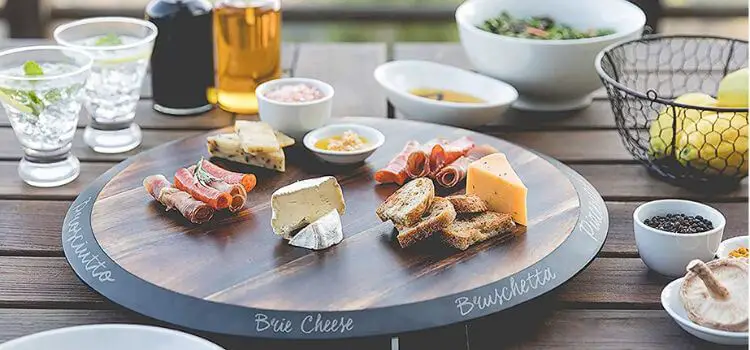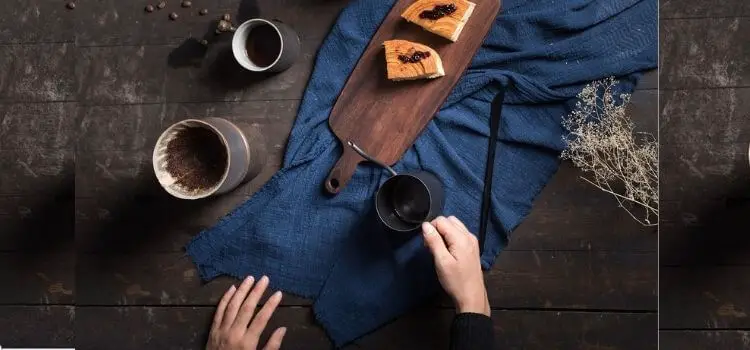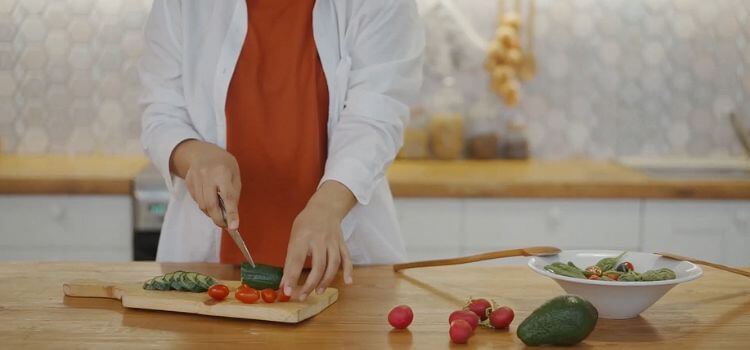
A charcuterie board can be a beautiful piece of kitchenware, but can it work as a cutting board too? Many people wonder if they can combine these two functions. Let’s explore whether it’s a good idea to use a charcuterie board as a cutting board.
Let’s explore the practicalities, advantages, and potential downsides of using a charcuterie board as a cutting board to help you make the best choice for your kitchen.
Understanding Charcuterie Boards vs. Cutting Boards
a charcuterie board and a cutting board might look like interchangeable flat surfaces. They are both boards, typically made of wood, slate, or marble, and serve as handy kitchen tools. But, while a cutting board is primarily used for slicing and chopping, a charcuterie board is meant for presenting food.
A charcuterie board is usually thinner, smoother, and has a decorative look because it’s designed to display an array of foods.
Cheeses, cured meats, fruits, nuts, and crackers are often arranged on a charcuterie board for an inviting display. A cutting board, on the other hand, is built for durability, intended to withstand heavy-duty use, including the slicing of meat, vegetables, and bread.
Using a cutting board daily involves constant knife contact, which many charcuterie boards simply aren’t designed for.
What Makes a Good Charcuterie Board?
A high-quality charcuterie board focuses on aesthetics and presentation. Materials used for charcuterie boards are often chosen for their looks and ability to resist stains or odors. These boards are crafted to highlight the colors and textures of foods, enhancing the visual appeal of any spread. Common materials for charcuterie boards include:
- Wood: Bamboo, acacia, and walnut are popular choices for charcuterie boards because they offer a warm, rustic look. These woods are often polished to prevent foods from sticking and to create a smooth, attractive surface.
- Slate: Known for its dark, elegant appearance, slate provides a natural contrast to bright foods. Slate charcuterie boards are best suited for displaying cheeses or fruits rather than heavy chopping tasks.
- Marble: Marble boards offer a sophisticated, glossy surface that stays cool, making them ideal for cheeses. Marble is, however, a very hard surface that can dull knives quickly if used for cutting.
These materials highlight food and create a beautiful presentation, but they don’t necessarily hold up well against constant knife work. A good charcuterie board also focuses on ease of cleaning since serving boards often need quick wiping to stay presentable for the next use.
Characteristics of an Effective Cutting Board

A cutting board, by contrast, is all about function and durability. Cutting boards must handle repetitive knife strikes and offer a surface that doesn’t dull blades too quickly. Cutting boards come in various materials, each offering different advantages for kitchen use:
- Wood: Hardwood cutting boards, made from maple, teak, or bamboo, are popular for their durability and knife-friendly surface. Wood boards are thick enough to withstand chopping but soft enough to protect knife edges.
- Plastic: Plastic cutting boards are commonly used for raw meats because they are easy to sanitize. They’re lightweight and often dishwasher-safe, making them practical for busy kitchens.
- Composite: Composite boards, made from a blend of wood fibers and resin, are durable and sanitary. They combine the sturdiness of plastic with the aesthetics of wood and are resistant to scratches and warping.
Cutting boards are typically thicker than charcuterie boards, absorbing the impact of knives more effectively. They’re designed to be easy to clean, especially for handling raw meats and other foods that require sanitation to prevent cross-contamination.
Can a Charcuterie Board Handle Cutting Tasks?

Using a charcuterie board as a cutting board can seem convenient, but it’s not without drawbacks. Most charcuterie boards aren’t designed to endure the rigorous demands of chopping, slicing, or dicing. Here’s why:
- Durability: Charcuterie boards are often thinner and lack the thickness needed for consistent cutting. This can lead to warping, splintering, or cracking over time, especially if you’re using a heavy chef’s knife or cleaver.
- Scratch Resistance: Knife marks can quickly mar the smooth, polished surface of a charcuterie board. Over time, these cuts can damage the appearance of the board and make it harder to clean.
- Finish and Coating: Many charcuterie boards have finishes or coatings that are not intended for knife contact. These finishes may be damaged by repeated cutting, and the board may lose its charm after sustained use.
While it may be okay to use a charcuterie board for light tasks, such as cutting soft fruits or vegetables, frequent use as a cutting board can decrease its lifespan. Eventually, it could lose its attractive look and even develop grooves that trap food particles and bacteria.
Material Matters: The Role of Wood, Marble, and Slate
The type of material you choose for your charcuterie or cutting board significantly impacts its durability, ease of maintenance, and knife compatibility.
- Wood: A popular choice for both charcuterie and cutting boards, wood offers a warm, natural appearance. Hardwood charcuterie boards may handle occasional cutting but are often too polished or thin for heavy knife work. Cutting boards made from hardwoods, however, are built for chopping, making them a safer bet if you want a dual-purpose board.
- Marble: Marble charcuterie boards add elegance to any food display but are unforgiving on knives. Marble is extremely hard, and using it for cutting can quickly dull knife edges. Marble boards are also prone to stains from acidic foods and are generally better suited for display rather than cutting.
- Slate: Often used for charcuterie boards due to its dark color and natural appeal, slate doesn’t fare well as a cutting surface. Slate can scratch easily, and like marble, it is very hard on knife blades. Slate is typically reserved for presentation purposes.
Choosing the right material is essential to extending the life of your board. If you plan to use one board for both cutting and serving, hardwood or bamboo may provide the best balance between durability and aesthetics.
Hygiene Concerns: Why Mixing Cutting and Serving Surfaces Can Be Risky

Cutting boards are designed to handle raw meats, vegetables, and other ingredients that may carry bacteria. Charcuterie boards, however, aren’t always made with sanitation in mind. Many charcuterie boards have a porous surface, which can absorb juices from meats or other foods. When a board absorbs these juices, it can harbor bacteria, increasing the risk of cross-contamination.
Using a charcuterie board for both cutting and serving can create hygiene issues, especially if raw and cooked foods are placed on the same surface. If you’re planning to use a board for cutting, it’s crucial to sanitize it thoroughly between uses. This is easier with plastic and certain wood cutting boards, as they’re designed to withstand washing and disinfecting without warping or cracking.
Preserving Your Charcuterie Board’s Quality
If you’re set on using a charcuterie board for occasional cutting, there are ways to minimize wear and keep the board looking fresh. Here are some tips:
- Stick to Soft Foods: Use the board only for cutting softer items like bread or soft cheese. Avoid hard foods, as they can scratch the surface and leave unsightly marks.
- Avoid Raw Meat: Don’t use a charcuterie board to cut raw meats or fish. The board may absorb juices and develop bacteria, making it difficult to sanitize.
- Oil Regularly: Wooden charcuterie boards benefit from regular oiling. Oiling helps protect the wood, prevents cracking, and maintains a polished look.
- Hand Wash Only: Most charcuterie boards aren’t dishwasher-safe, so wash them by hand with mild soap and water.
Alternatives to Using a Charcuterie Board as a Cutting Board
If you need a board that can handle both cutting and serving, some multipurpose boards are designed for this exact use. These boards are durable enough to withstand light cutting and have an attractive surface for serving. Many multipurpose boards are made from bamboo or hardwood, which are both stylish and practical.
For those who entertain frequently and want a dual-purpose board, it may be worthwhile to invest in a high-quality wood cutting board that can also function as a charcuterie board. Just be mindful that using it for cutting will still lead to wear and tear over time.
Final Thoughts: Is a Charcuterie Board Suitable as a Cutting Board?
A charcuterie board can be used as a cutting board, but it may not be ideal for regular knife work. The best practice is to use each board for its intended purpose. Cutting boards offer durability for chopping, while charcuterie boards are crafted for beautiful food displays.
Using your boards for their specific purposes will keep them in better shape and ensure they last longer. A well-cared-for charcuterie board can add elegance to your serving style, while a dedicated cutting board will handle all the heavy work in the kitchen. By choosing wisely, you can enjoy the best of both boards and keep your kitchen looking stylish and functional.
Leave a Reply